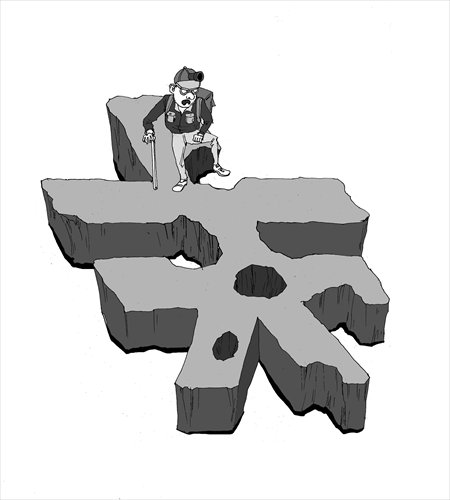Monetary policy predicament may undermine reforms

Illustration: Luo Xuan/GT
The first four months of 2016 have been tough for China. Potential financial risks such as the yuan exchange rate, credit bonds, private financial products, banks' bad assets and overvalued sectors of the stock market are likely to persist for a long time.
Meanwhile, we should also pay attention to the potential risk brought by the increase in the consumer price index (CPI), a main measure of inflation. Official statistics have shown the CPI for February 2016 jumped to 2.3 percent from 1.8 percent a month earlier. If we attribute the big jump to an increase in prices of pork and vegetables, such seasonal factors will eventually abate. But the rebound in commodity prices will drive up the core CPI, making the rise of CPI more rigid.
The 2016 Chinese government work report enhanced the growth target for M2, the broad measure of money supply, to 13 percent. This suggests the difference between M2 growth and nominal GDP growth will exceed 6 percent, presumably a record high. M2's high growth has provided abundant liquidity in the market, which has made it difficult to find proper investment over the past year.
The possibility of moderate inflation in China this year can also be further analyzed. People normally hold the assumption that if the yuan doesn't depreciate against other currencies, then it will depreciate domestically, which means inflation will occur. Meanwhile, Monetarism, a school of economic thought, believes inflation would occur when M2 growth has distinctly exceeded nominal GDP growth. China seems to be facing both situations.
By looking at the four phases of inflation in China since the 1990s, whenever the nominal GDP growth was greater than M2 growth, the CPI reached a peak. The peaks of CPI have kept pace with that of nominal GDP growth, with no exception. This means, if there is inflation, the nominal GDP growth must be rising up. Given that nominal GDP isn't adjusted for inflation, the increase in the PPI is pivotal, since the price increases at the producer level can be passed through to the CPI.
For 2016, despite the absolute value of negative PPI is expected to narrow, the indicator is still unlikely to turn positive. In this regard, the difference between nominal GDP and real GDP is estimated to be slim. This suggests the CPI will continue to rise without reaching the peak.
In a nutshell, the real GDP growth can be used as a main basis of judging whether there is inflation. If the Chinese economy bottoms out this year, it will see an upward swing in 2017, and the possibility of a rise in inflation will be greater.
But no matter whether the economy will bottom out or not, the CPI is projected to be maintained between 2 percent and 3 percent, with a greater possibility of moderate inflation.
From 2013 to 2014, the difference between growth rates of M2 and nominal GDP were within the range of 3 percent to 4 percent, but it jumped to 6.88 percent in 2015.
This was mainly due to the loosening of monetary policy, for instance five cuts respectively in the interest rates and reserve requirement ratio (RRR), which have also contributed to the current rise in the CPI.
According to past experience, the monetary policy would be tightened when the CPI goes up, which then is followed by decreases in the M2 growth. In this regard, we should stay alert to the negative effects brought by a shift in the monetary policy.
The Chinese economy is likely to be less elastic and will fluctuate within a narrower band following its expansion in volume. After an economic downturn, apart from decreases in the bulk commodity prices, the prices of financial assets and properties have hit a record high, and labor costs have continued to rise. Meanwhile, China's floating population is falling and aging population is rising. Such circumstances reduce the scope of monetary policy interventions.
If the GDP growth accelerates, it certainly will be reassuring if the authorities tighten the monetary policy. What's worrying is if inflation rises but the GDP growth remains flat. If so, how should the monetary policy react? This year's government work report has set the CPI target at 3 percent, and the People's Bank of China (PBC), the central bank, has set inflation control as the most important objective among a total of four objectives. The PBC is unlikely to tighten policy until the CPI reaches 3 percent. In my opinion, once the CPI has exceeded 2.5 percent, the PBC will make preparations for a policy adjustment, and will implement tightening measures once the index has exceeded 2.8 percent.
In this regard, inflation expectations are more dreadful than depreciation expectations in yuan, because the former is uncontrollable but the latter is controllable with capital controls. If inflation really goes up, the authorities have to tighten the monetary policy, which would be harmful to the stock market and the property market that have plenty of bubbles in them, and to the real economy.
I estimate the CPI will have a limited increase, which is likely to stop at slightly above 3 percent. In that case, the monetary policy won't need to be tightened too much. The shift in the monetary policy is not a good thing. Even though it can contain the outbreak of risks, it doesn't solve underlying issues of the economy, and at best only delays a crisis.
Under the twin pressures of preventing risks and stabilizing growth, and under the twin expectations of inflation and yuan depreciation this year, the authorities will be facing a big challenge in pushing forward greater reforms.
The author is chief economist at Haitong Securities, bizopinion@globaltimes.com.cn